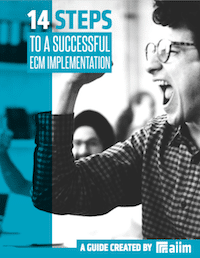The AIIM Blog
Keep your finger on the pulse of Intelligent Information Management with industry news, trends, and best practices.
Cloud | Enterprise Content Management (ECM)
I had a great call this morning with a group from Tieto. Tieto is an IT service company providing IT, R&D, and consulting services. Tieto's main markets are the Nordic countries, Russia and Poland. In addition, Tieto serves its customers globally in certain areas of expertise and has industry-specific activities in selected countries.
Share
I was reading the Wall Street Journal when an ad caught my eye. The caption read "PaperBecause -- It's Easier to Learn on Paper." The campaign is sponsored by a Domtar, "the largest integrated manufacturer and marketer of uncoated freesheet paper in North America and the second-largest in the world."
Share

Making an ECM implementation successful requires planning and attention to detail. The best way to create the right solution is to identify organizational goals and priorities. Learn how to manage a successful implementation in our free guide.
Enterprise Content Management (ECM)
Okay, I've got a confession to make. I might be guilty of spreading an urban legend. Yikes! Many of us who present on content management often cite a 1998 study by Coopers & Lybrand (1998) in our presentations. Here are some of the typical data points: 90% of corporate memory exists on paper Out of pages that get handled in the office, 90% are merely shuffled The average document gets copied 19 times Companies spend an estimated $20 in labor to file a document, $120 in labor to find a misfiled document, and $220 in labor to reproduce a lost document 7.5% of all documents get lost, 3% of the remainder get misfiled, a total 10.5% of problematic documents Professionals spend 5-15% of their time reading information but spend 50% looking for it A typical worker spends thirty minutes to two hours a day searching for documents While many of us have used these stats in a million presentations, I wonder, "Does anyone have the original report? Does anyone know the actual name of the report?"
Share
Enterprise Content Management (ECM)
1. Look at New Approaches to Software Acquisition Back at the turn of the century (yes, we mean the late 1990s...), there was but one way to acquire a content management product to meet enterprise document or records management needs. We bought per-seat or per-server licenses that shipped on CD from the software vendor, crossed our fingers that we budgeted for enough seats or connections for key employees, all while hoping that the vendor roadmap delivered the fixes and features we quickly realized were missing. In 2010 things are different. The options to acquire ECM software have changed dramatically, offering a far richer range of choices to serve customer needs—not just those of the vendor. Open source and Software-as-a-Service (SaaS) are two new approaches that put power back into the hands of the enterprise. Simple, clear online downloads or subscription sign-ups via the web cut through the red tape of license keys, the endless sales cycle theatrical negotiations, and lets your team get started on an ECM project today.
Share
While creating an Information Management Strategy, you need to determine the most important piece to getting your documents digitized and that is the scanner. There are many choices on the market ranging from low end, 25 pages per minute and up desktop scanners to production scanners that will perform at 100 pages per minute and up. Almost all have duplex scanning to scan both sides of a document.
Share
To the frustration of information architects and managers, end users have a habit of spoiling their hard work the moment they start using the system. The symptoms are many and varied: carefully designed folder structures devolve into chaos over time; despite training on document version control, copies of the same file keep appearing with version numbers, dates, and initials in the file name (e.g., "Proposal v.2 MP Comments.doc"); templates are used inconsistently or even ignored; automated workflows spawn undocumented manual workarounds... Aren't these precisely the kinds of things that our expensive, carefully planned ECM system was supposed to eliminate?
Share